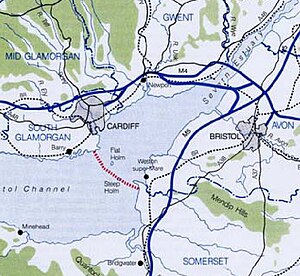| English: Map of proposed . (Photo credit: Wikipedia) |
Two years after the government decided to shelve pans for a tidal barrage across the river Severn, the idea is back according to the BBC.
The project to build a tidal barrage from Brean Down near Weston-super-Mare to Lavernock Point near Cardiff was originally put on hold in 2010 when the then newly-elected government was in the first phase of its government budget cuts. With an estimated price tag of £20 billion, the Secretary of State for Energy and Climate Change at the time, Chris Huhne, declared the project unaffordable.
It now transpires that former shadow Welsh Secretary Peer Hain has been busy putting together a private finance initiative for the project, and that the plans are currently receiving serious consideration at the Prime Minister's office. The proposal would see the project financed by money from the Gulf states of Kuwait and Qatar, with the energy and engineering consortium Corlan Hafren being the leading player in the proposal.
In assessing the suitability of the current proposal, it is to be hoped that the government will consider the following issues:
1. The requirement for public ownership
In its 2007 report on a proposed Severn Barrage, the Sustainable Development Commission stated that, in order to be considered as a sustainable project,
"A Severn barrage must be publicly led as a project and publicly owned as an asset to avoid short-termist decisions and ensure the long-term public interest."
The SDC was closed by the government in 2010 as part of its cost-cutting agenda. Announcing the closure at the time, Caroline Spelman, Minister at the
Department for Environment, Food and Rural Affairs stated that,
"This government is committed to being the greenest government ever."
Less positively, Jonathon Porritt, chair of the SDC from 2000 - 2009, declared that,
"The only conceivable reason for ... this .... is that the government doesn't want anyone independently auditing its performance on sustainable development - let alone properly-resourced, indisputably expert body operating as 'a critical friend' on an inside track within government."
Clearly, a privately-owned Gulf-funded barrage would not pass this public-ownership test.
2. Habitat Loss
The SDC's 2007 report also estimates that a major barrage scheme would result in the loss of up to 75% of the Severn's
internationally-protected inter-tidal habitat. This would presumably include the Slimbridge wildfowl reserve. Apart from the environmental destruction itself, the move would also be likely to leave the UK in breach of its European legal commitments on habitat conservation.
The SDC therefore called for alternative wildlife habitats to be "on an unprecedented scale" if a barrage project were to go ahead.
3. Related Infrastructure Development
Whereas the initial proposals for a barrage were distinctly coy about the idea of creating related infrastructure on and around the barrage, the revived plan by Corlan Hafren sees such development as central to the project, with a road and rail link planned for the top of the barrage. The following from the company's vision of the barrage is fairly typical:
"Part of this vision will be to use the barrage as enabling infrastructure to improve the transport connections between South Wales and the West Country and the remainder of England and to create substantial new and permanent jobs in addition to the interim construction jobs.
For the area immediately around the barrage and its impoundment, the vision is to create a sustainable city region that capitalises on the barrage investments....This city region will grow within a clear hierarchy of settlements connected by world class urban transport systems.....This will be by affordable and convenient public transport enhanced by international / European connectivity facilitated by improved heavy and light rail links, and motorways in the first instance and subsequently by upgrading the local airports."
In Peter Hain's mind. the barrage is clearly a vehicle for regenerating some of the deprived communities of south Wales and north Somerset. The question is, will such urbanisation and increased travel be factored in when assessing the long-term environmental benefit of the "carbon-neutral" electricity the barrier will produce?
On a more tangible level, do we actually want a motorway running across the top of Brean Down? Could such a development be described as "environmentally benefical" in any normally-understood sense of the word?
4. The Impact on Shipping
Although the proposed barrage would have lock mechanisms to allow shipping to continue beyond its walls, the added time such a development would add to journeys may result in ports to the east of the barrage suffering a gradual decline in trade relative to those to its west.
Matthew Kennerley, director of Associated British Ports (ABP),
when giving evidence to a Parliamentary committee in 2009, stated that after the short-term construction boom, the barrier would slow entry to the ports of Cardiff, Avonmouth, Portbury and Newport.
.
The main beneficiary could be Port Talbot, in south Wales, he predicted.
If you enjoyed this post, get free updates by email or RSS.


No comments:
Post a Comment